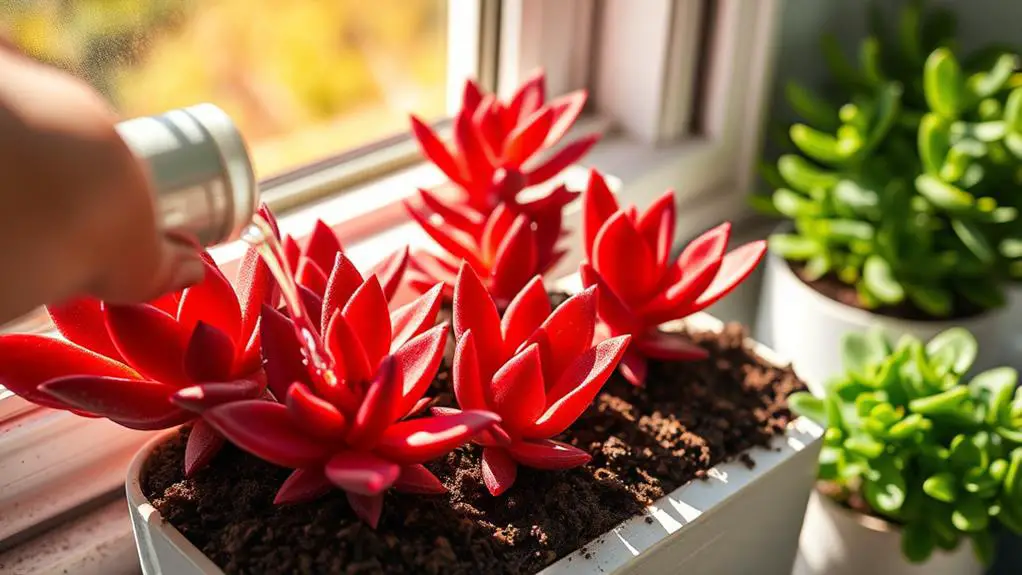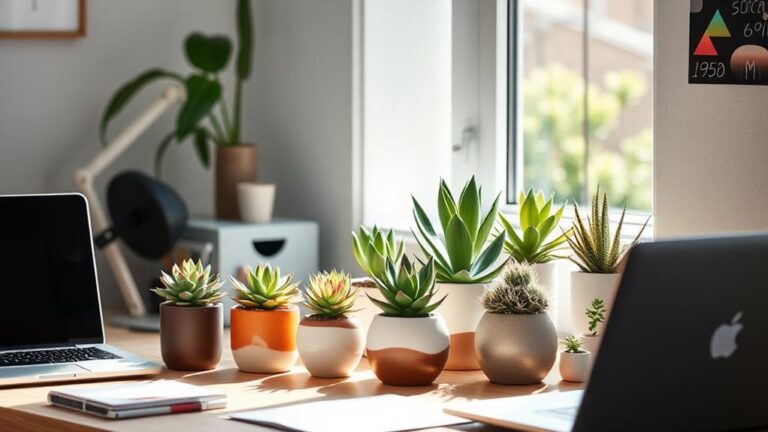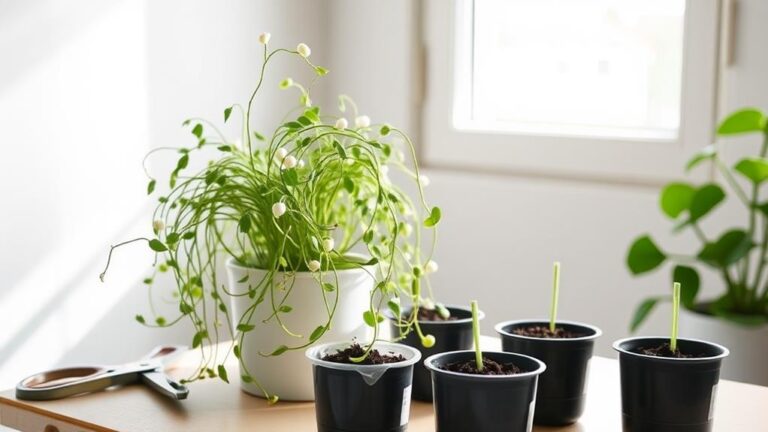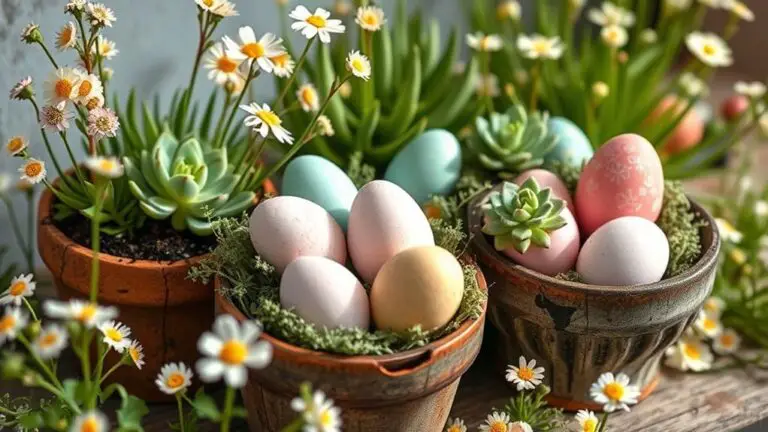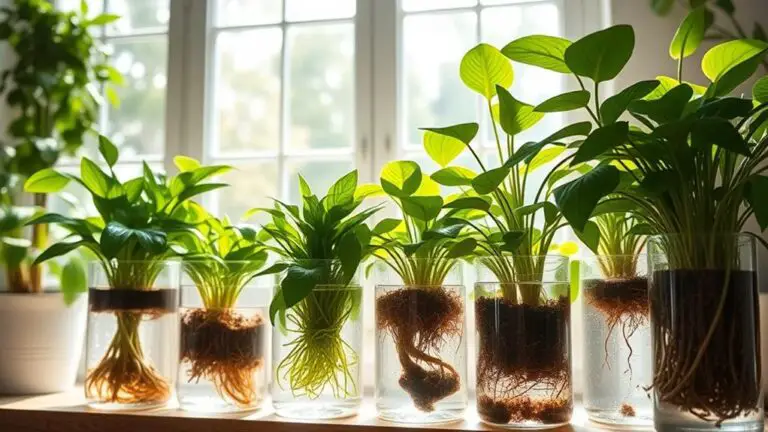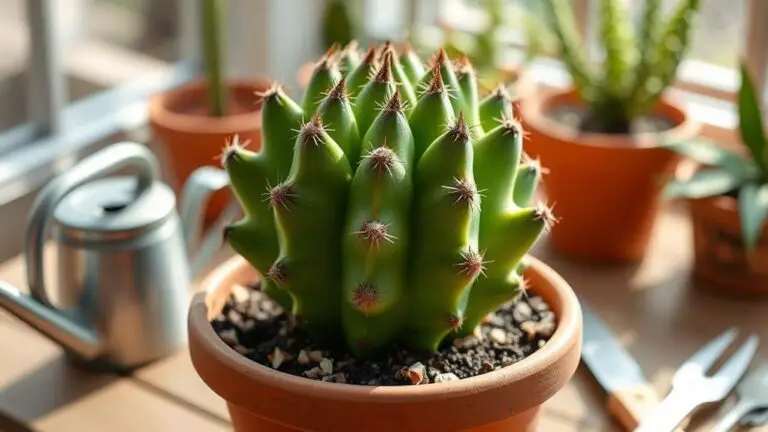10 Steps to Make My Succulents Turn Red
If you're looking to give your succulents a stunning red hue, you'll need to follow a few specific steps to achieve those vibrant colors. Start by ensuring your plants get at least six hours of bright sunlight each day, which is essential for bringing out those rich tones. You'll also want to carefully adjust your watering schedule to avoid overhydration. But that's just the beginning. There are additional techniques involving temperature control, soil composition, and even purposeful stress that can amplify your succulents' color transformation. Curious about how these methods work in harmony? Let's explore further.
Increase Sunlight Exposure
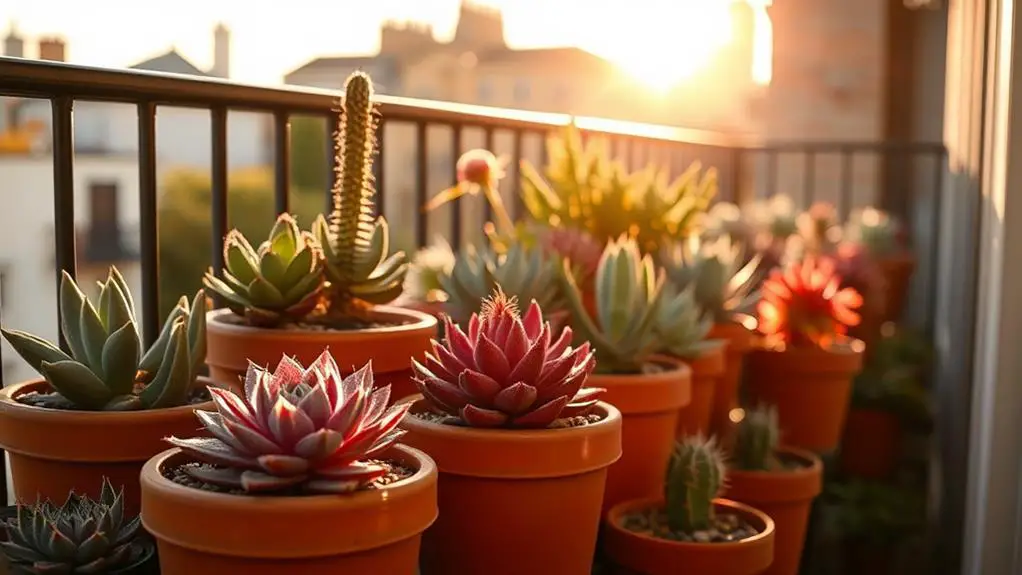
To make your succulents turn red, increasing their sunlight exposure is essential. Succulents need at least 6 hours of bright sunlight each day to enhance their pigmentation, resulting in vibrant red hues.
Place your indoor succulents near south-facing windows where they can soak up the most sunlight. If your succulents are outside, guarantee they get enough bright sunlight by positioning them well.
Watch for signs of light stress, like fading leaves or leggy growth, and adjust their placement as needed.
Gradually Acclimate Succulents
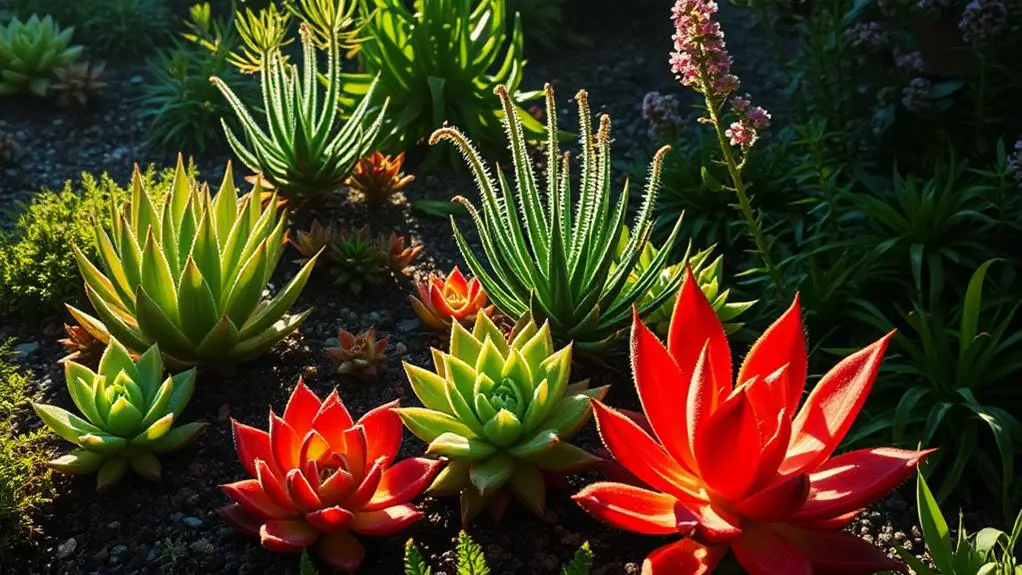
To help your succulents turn red, start by placing them in a shaded area for 4-7 days to gradually increase their sunlight exposure.
Slowly introduce them to bright, indirect light, making sure they get at least 6 hours of light daily while adjusting their watering schedule slightly.
Keep an eye on their leaves for any signs of light stress, and adjust temperature and light exposure carefully to avoid overwhelming the plants.
Increase Sunlight Exposure
Gradually increasing sunlight exposure is essential for turning your succulents red. Start by placing them in bright shade for 4-7 hours a day. This initial step helps to gradually acclimate your plants without causing shock.
Gradually increase the amount of sunlight they receive, aiming for a minimum of 6 hours daily. This will activate pigments like carotenoids and anthocyanins, leading to a beautiful color change.
During this process, monitor your succulents for any signs of light stress or sunburn. A 1-2 week adjustment period is vital if your plants were previously in low light.
Place them near south-facing windows or outdoor areas with full sun to help them develop vibrant colors.
Monitor Watering Schedule
When aiming to turn your succulents red, adjusting your watering schedule becomes crucial. Gradually reduce watering frequency to encourage drought stress, which enhances red pigmentation.
Allow the soil to dry completely between waterings; this helps the plant store more moisture in its leaves, promoting color changes. Monitor your succulent's response to reduced watering and adjust accordingly to avoid over-stressing, which can cause damage.
Aim to extend the time between waterings to 2-3 weeks, depending on the variety and environmental conditions.
While reducing water, guarantee your succulents get adequate sunlight exposure, as this combination is key to achieving vibrant red hues.
Adjust Temperature Gradually
Acclimating your succulents to higher temperatures can considerably enhance their red pigmentation. To achieve this, you need to gradually adjust their environmental conditions to avoid temperature stress.
- Increase the heat: Raise the temperature by 5°F to 10°F every few days. This gradual change helps succulents acclimate without shock.
- Ideal range: Keep the temperature between 60°F to 80°F. This range enhances succulent color without causing stress.
- Monitor health: Watch for signs of stress like wilting or color fading. Adjust temperatures if needed to maintain your plants' health.
- Track changes: Use a thermometer to verify temperatures don't exceed 90°F. Excess heat can damage rather than enhance color.
Optimize Watering Schedule
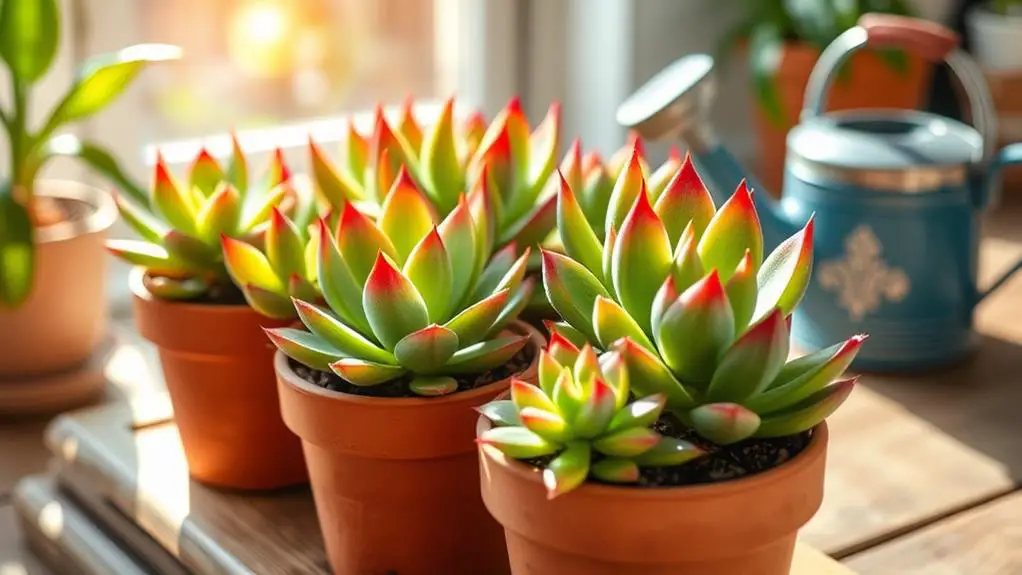
To help your succulents turn red, it's important to optimize your watering schedule.
By slightly reducing how often you water and letting the soil dry out completely between waterings, you can create mild drought stress that encourages beautiful red hues.
Just be careful not to let them dry out for too long, as this can harm your plants instead of helping them!
Controlled Water Stress
Embracing a controlled water stress strategy can work wonders for turning your succulents red.
Start by letting the soil dry completely between waterings. This helps the plant store moisture in its leaves, creating stress-induced pigmentation. Gradually reduce the frequency of watering to allow slight drought conditions, enhancing color intensity.
Be sure to monitor moisture levels carefully; overwatering will keep your succulents green by reducing stress and inhibiting pigment production. Aim for a routine where you water deeply but infrequently, giving the plant time to recover and develop vibrant colors.
Here's a simple guide:
- Let soil dry completely between waterings.
- Reduce watering frequency gradually.
- Monitor moisture levels to avoid overwatering.
- Water deeply and infrequently.
Extended Dry Periods
After mastering controlled water stress, it's time to refine your watering schedule to include extended dry periods. By letting the soil dry out completely for several weeks, you can encourage the color of succulents to change. This drought stress helps them produce pigments like anthocyanins, enhancing the intensity of red or purple hues. However, be careful to monitor your plants closely to avoid over-stressing them, which can cause damage. Experiment with different schedules, such as watering every two weeks instead of weekly.
Here's a simple table to guide you:
| Watering Interval | Soil Condition | Color Change |
|---|---|---|
| Weekly | Moist | Minimal |
| Bi-weekly | Dry | Enhanced |
| Monthly | Very Dry | Most Intense |
Reduced Water Frequency
Reducing water frequency is a key strategy for making succulents turn red. By letting the soil dry completely between watering, you create a bit of drought stress, which can result in vibrant color changes.
It's important to monitor your plants closely to avoid over-stressing them.
Here's how you can optimize your watering schedule:
- Water Less Often: Gradually extend the time between watering sessions.
- Check Soil: Verify the soil is dry completely before watering again.
- Observe Changes: Look for red tips or pink hues as signs of healthy drought stress.
- Adjust Gradually: Don't make sudden changes; aim for a balance that promotes both health and color changes.
Following these steps can help your succulents thrive and show off their beautiful red hues!
Monitor Temperature Levels
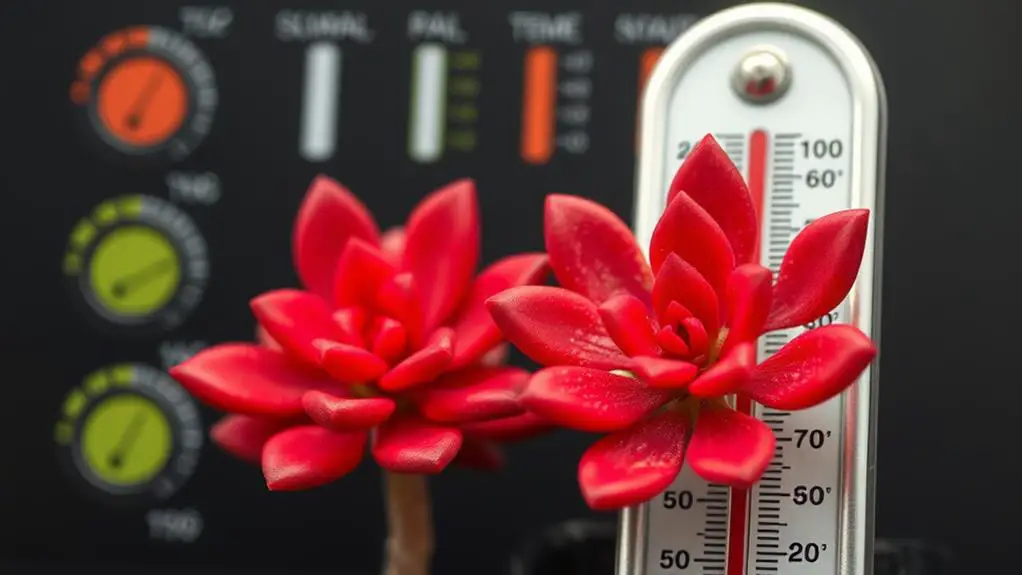
Keeping an eye on temperature levels is vital for making succulents turn red. Temperature fluctuations can stress your plants, encouraging them to shift from green to red. Aim to keep ambient temperatures between 60°F and 80°F.
High temperatures above 90°F can trigger the production of protective pigments, resulting in beautiful red and purple hues. On the other hand, cold temperatures below 40°F can enhance chlorophyll activity, darkening the foliage but also sometimes causing colorful blushes in frost-tender varieties.
It's important to monitor temperature levels closely to guarantee your succulents aren't exposed to harmful extremes. By adjusting their environment carefully, you'll help them thrive and display those vibrant colors you desire.
Use High-Phosphorus Fertilizers
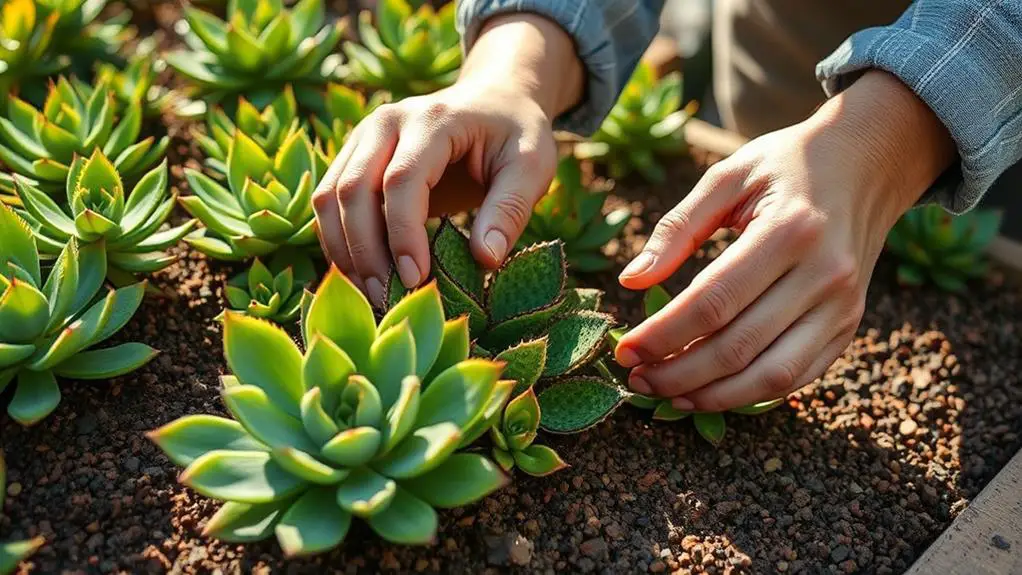
To make your succulents turn red, consider using high-phosphorus fertilizers.
These fertilizers enhance the production of anthocyanins, which are responsible for those bright colors in your succulents. When choosing a fertilizer, look for an N-P-K ratio that emphasizes phosphorus, like 5-10-5 or 10-20-20.
Here's your step-by-step guide:
- Select the right fertilizer: Choose one with high phosphorus content to promote red pigmentation.
- Apply during the growing season: Use the fertilizer in spring and summer for the best results.
- Avoid over-fertilization: Stick to recommended application rates to prevent stressing your plants.
- Monitor moisture levels: Regularly check the soil mix to maintain ideal conditions for your succulents.
Choose Proper Soil Mix

To help your succulents turn red, you need to choose the right soil mix.
Make sure it's at least 50% inorganic matter, like perlite or pumice, to improve drainage and aeration.
This will prevent overwatering, which often leads to green, rather than red, succulents.
Ensure Proper Drainage
Achieving those vibrant red hues in your succulents starts with guaranteeing proper drainage by choosing the right soil mix.
Here's how you can do it:
- Use a well-draining cactus or succulent-specific potting mix to balance aeration and moisture retention.
- Guarantee your potting container has drainage holes. These holes let excess water escape, preventing root rot and waterlogged soil.
- Regularly check soil moisture levels. The soil should dry out completely between waterings to help your succulents store moisture and change color.
- Avoid excessive organic materials like peat moss, which can retain too much moisture and hinder your succulent's health and color.
Use Inorganic Matter
When aiming for those striking red hues in your succulents, incorporating inorganic matter into your soil mix is vital.
Choose a soil mix specifically designed for succulents, containing at least 50% inorganic matter like perlite or pumice. This guarantees proper drainage and aeration, which are essential for vibrant succulent colors.
Avoid using excessive organic matter, such as peat moss, as it retains too much moisture and can cause root rot, preventing color changes.
Regularly check the soil pH, keeping it between 6.0 and 7.0 to support nutrient availability.
Repot your succulents into well-draining containers, allowing airflow to the roots. This promotes overall plant health, enhancing those beautiful red hues you're aiming for.
Select Colorful Varieties
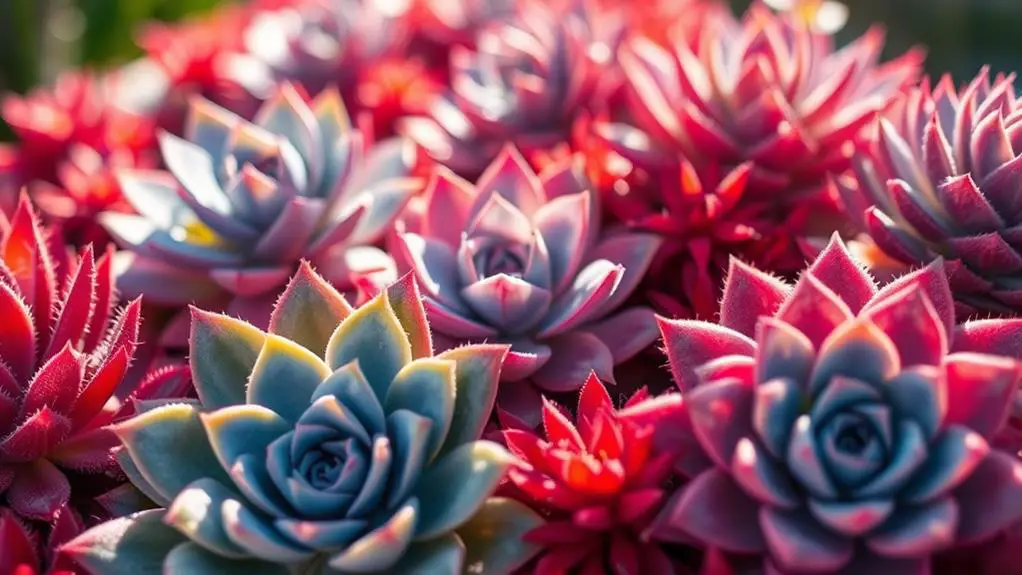
Choosing vibrant succulents is a key step in making your plants turn red. Consider selecting colorful varieties that respond well to light stress and can change colors under the right conditions.
Echeveria species are renowned for their striking red hues, especially when exposed to sun all day. Sedum varieties can exhibit deep reds and purples with adequate sunlight.
Graptopetalum features unique pastel shades that turn red under stress, offering a colorful display. Aeonium rosettes develop reddish tones when exposed to full sun and varying temperatures.
To help you choose:
- Echeveria – Known for vibrant reds.
- Sedum – Shows deep reds and purples.
- Graptopetalum – Turns red under stress.
- Aeonium – Changes colors with sun exposure.
Stress Succulents Purposefully
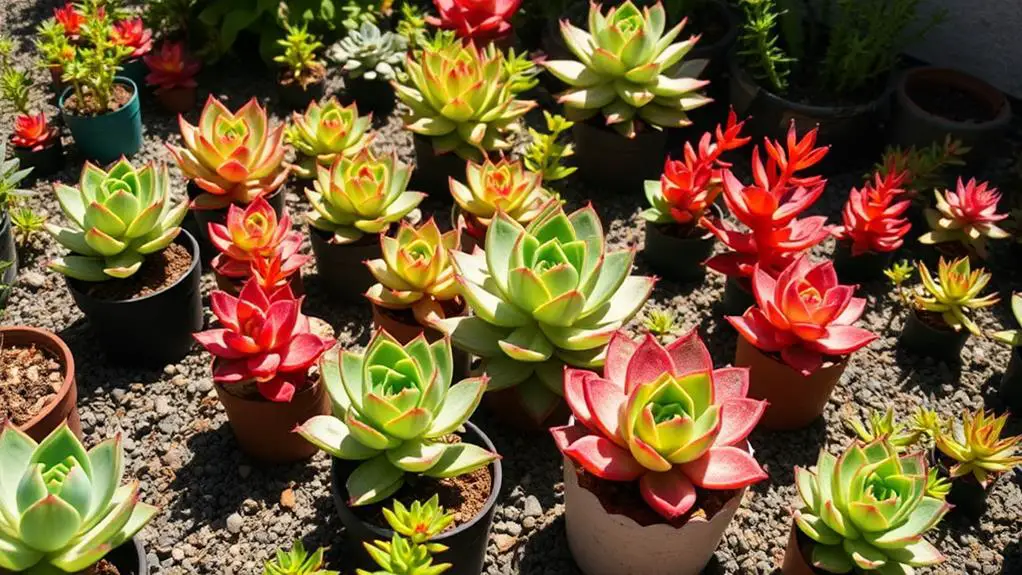
While selecting colorful varieties lays the groundwork for vibrant red succulents, the next step focuses on purposeful stress to enhance their hues. To stress succulents purposefully, reduce the amount of water. Let the soil dry completely between waterings. Gradually increase the amounts of light by starting with bright shade and moving to direct sunlight. This helps activate protective pigments. Encourage temperature fluctuations by keeping succulents warmer during the day and cooler at night. Use fertilizers high in phosphorus sparingly to avoid excessive green growth.
| Factor | Action | Result |
|---|---|---|
| Amount of Water | Reduce watering frequency | Enhances red coloration |
| Amounts of Light | Increase exposure gradually | Activates pigments |
| Temperature | Warm days, cooler nights | Boosts pigmentation |
| Fertilization | Use sparingly | Prevents overgrowth |
| Monitoring Health | Closely observe plant condition | Prevents damage |
Monitor your succulents' overall health to avoid damage from extreme stress.
Prune for New Growth

Pruning your succulents is an essential step in encouraging vibrant new growth. By removing older, less colorful leaves, you help your plant produce more vibrant foliage.
Regular pruning succulents also shapes them nicely and allows better light exposure, which enhances pigmentation. Here's a simple guide to get you started:
- Use Clean, Sharp Tools: Always use sterilized, sharp scissors or shears to prevent disease and promote healthy regrowth.
- Prune in Growing Season: Aim to prune in spring or early summer when the plant is actively growing, encouraging new, colorful shoots.
- Remove Leggy Growth: Cut back any long, thin stems to stimulate the production of new, vibrant shoots.
- Maintain Ideal Shape: Regular trimming helps keep your succulents at the perfect size and shape for maximum light exposure and color.
Avoid Overwatering

Overwatering is one of the most common mistakes succulent enthusiasts make, leading to a host of problems, including dull, green leaves.
To avoid overwatering, make sure to let the soil dry out completely between waterings. Succulents thrive on stress, and this can enhance their red hues. Regularly check the moisture level of the soil; if it stays damp, you might be giving them too much water.
Improve drainage by using a well-draining soil mix with perlite or pumice. This prevents water retention and root rot, which dulls their color.
Adjust your watering schedule with the seasons, especially during winter when succulents need less water. By getting the right amount of water, you'll see vibrant, red succulents.
Frequently Asked Questions
How to Make Succulents Turn Red?
Make certain your succulents get at least 6 hours of bright sunlight daily. Reduce watering gradually, expose them to higher temperatures, and use phosphorus-rich fertilizers. Regular pruning also helps encourage new, vibrant red growth.
How Do I Get My Succulents to Change Color?
To get your succulents to change color, give them 6 hours of bright sunlight daily, reduce watering to create slight stress, vary temperatures, and use high-phosphorus fertilizers. Monitor for signs of light stress and adjust as needed.
How to Make Succulents Greener?
To make your succulents greener, give them plenty of light and water regularly. Use well-draining soil and fertilize during the growing season. Keep them in stable temperatures between 60°F to 80°F for ideal green growth.
What Color Are Stressed Succulents?
Stressed succulents often turn red, pink, purple, or blue due to environmental factors like sunlight, temperature changes, and drought stress. When they produce protective pigments, their colors become more vibrant and striking as a survival mechanism.
Conclusion
You've got this! By following these steps, you'll help your succulents turn a stunning red. Remember to give them plenty of sunlight, water them less often, and keep them in the right temperature range. Don't forget to use high-phosphorus fertilizers and pick colorful varieties. Stressing them a bit and pruning can also make a big difference. With a little patience and care, your succulents will thrive and show off their vibrant colors. Happy gardening!

